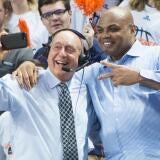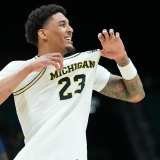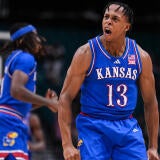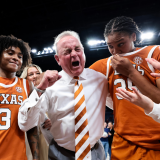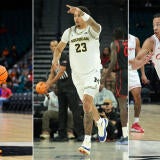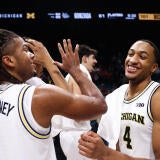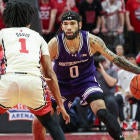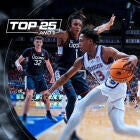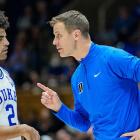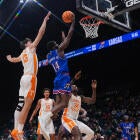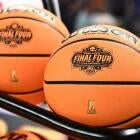2024 NCAA Tournament: Building the perfect team made for a grueling March Madness run
Here's the best of the best from this year's NCAA Tournament field

Choosing superlatives from across Division I college basketball is not easy. There are 362 teams, all with varying styles, varying strengths of schedules and varying consistencies. Do you prefer a team that is unstoppable at its best, but getting "its best" is rare? Do you prefer a team that is consistently really good but rarely takes it to an elite level?
During the NCAA Tournament, you need a combination of both: true excellence when it's required, but also enough consistency to survive six grueling games against opponents who all have different styles, strengths and weaknesses of their own. Being great here or there might lead to a nice run. Being good enough all the time is what makes a champion.
So what if you could combine the best attributes from teams in this NCAA Tournament and make one super (and super-sized) team? Here's the best of the best in this year's bracket.
Don't get caught on the bubble! Get your brackets in now to compete for the chance to win a new Nissan Rogue and Final Four® trips!
Note: All advanced stats are via Synergy, unless otherwise noted.
Offense
Best overall offense: UConn
UConn has all the pieces. Tristen Newton is an experienced point guard who can score from anywhere, rebound and assist. Donovan Clingan is an efficient post scorer who also earns the Huskies a ton of extra opportunities. It's a terrific combination to start with, and both return from last year's title-winning team.
Then you get everyone else, and each contributor seems to have the perfect role. Cam Spencer (44%) and Alex Karaban (39%) can absolutely stroke it from 3. Spencer provides secondary ball-handling ability, while the 6-foot-8 Karaban can be a small-ball center in short spurts and really stretch the defense. Stephon Castle is a standout athlete with an NBA-ready body who attacks the rim fearlessly. Samson Johnson is a rim-running, lob-catching backup to Clingan, Hassan Diarra is a capable distributor and solid shooter at either guard spot, and even little-used Jaylin Stewart came on strong in the Big East Tournament.
But it's not just the players, it's their cohesiveness. They run an intricate offense -- 11th in the nation in points scored off cuts -- but rarely turn the ball over. They have the nation's sixth-best assist rate but also plenty of guys who can get their own shot. The Huskies could be the choice for several of the following categories, but they get the nod in the biggest one.
Best post offense: Purdue Boilermakers
Say what you want about Purdue's March disappointments and Zach Edey being the face of the worst one, last year's loss to Fairleigh Dickinson. The Boilermakers' post-up offense is ridiculous. Edey has been even better this season than last year's player of the year campaign, which is why he's assured of a second straight such award. Edey is shooting it better, turning it over less and drawing a truly absurd 9.7 fouls per 40 minutes per Kenpom, best in the nation by a wide margin.
I could sit here and show you his short jumpers and layups and dunks all game long. What's been more impressive is how he's become an offensive fulcrum. The Boilermakers assisted 50% of their makes at the rim last year. It's up to 54% this year, and Edey is a big reason why.
Best interior offense: Marquette Golden Eagles
As I explained when I wrote this piece last year, "It's important to differentiate between this category and the previous one: post offense possessions almost always result in interior scoring opportunities, but not all interior scoring opportunities come from post-ups."
Interior offense can come from cutters, drives and a bunch of other places, too. The choice here is the same as last year's as well. Marquette ranks third nationally in points per game around the basket (23.5), and the Golden Eagles do it in a bunch of different ways. Oso Ighodaro is a crafty interior scorer who is also a lob threat. Tyler Kolek is a downhill guard who does a lot of work in his paint, even though he can also knock down the 3. Everyone on Marquette cuts with abandon. The Golden Eagles rank in the 85th percentile or better on pick and roll ball-handler possessions, pick and roll roller possessions, cuts and in isolation. Their interior offense comes in so many ways.
Best transition offense: Texas Longhorns
This was a tough one. Illinois has the best transition player in the country in Terrence Shannon Jr. Teams like Western Kentucky and Samford score a ton in transition because of their absurdly fast pace. Kentucky might be the most lethal transition team at its best. Utah State and Gonzaga get the best shots in transition. So how do we end up with Texas? The Longhorns are, on a per-possession basis, the nation's most efficient transition team. They have players who can rim run (Dylan Disu, Dillon Mitchell, Kadin Shedrick), a guard who can shoot the lights out (Max Abmas) and another guard who can run the show (Tyrese Hunter). Overall, the Longhorns are ninth in transition effective field goal percentage. Texas doesn't play at the fastest pace, but when it does run, watch out.
Best perimeter shooting: Kentucky
This one was not tough. The Wildcats not only have the best 3-point percentage in the nation (41%), but they have have five guys making at least 37%. Reed Sheppard leads the charge at 52% -- a number so absurd it looks like a typo. Rob Dillingham (45%) and Antonio Reeves (44%) are also deadeye shooters, while Zvonimir Ivisic (38% on small volume) adds some shooting ability from the bigs. Justin Edwards even reached 37% after a slow start.
Best free-throw shooting: Clemson Tigers
Clemson is a trendy upset victim playing Mountain West Tournament champion New Mexico in the first round, but if the Tigers do fall, it won't be because of their free-throw shooting. At 79%, they are the tournament's best team at the stripe. Joe Girard (96%), Chase Hunter (87%) and PJ Hall (79%) are all outstanding.
Best ball security/passing: Northwestern Wildcats
Last year, I went with Virginia, which led the nation in assist-to-turnover ratio and had the country's lowest turnover rate. Then what happened? One of the most inexplicable turnovers of all time in a first-round loss to Furman. That's March!
Here's to hoping things go a little better for Northwestern. The Wildcats have the lowest turnover rate of any team in the tournament (13%) and assist on 60% of their makes, a top-25 rate nationwide. Fifth-year senior Boo Buie is one of the best guards in the nation, and it truly pained me to leave him off my top 10 guards who could lead a run, but Northwestern's injury woes (and the fact that they'd play UConn in the second round) pushed him off. If the Wildcats do make a run, however, it'll be behind Buie, who had a top-five assist rate in Big Ten play, and fellow guard Ryan Langborg, who not only led Princeton to the Sweet 16 last year but had the lowest turnover rate (6.8%) in Big Ten play this year.
Defense
Best overall defense: Houston Cougars
Oh man, this one was tough. Iowa State and Houston were No. 1 and No. 2 in KenPom's defensive efficiency, separated by hundredths of a point. The Cyclones shut down the Cougars in the Big 12 Tournament title game just days ago. Both are not only sound units, but disruptive ones at that. Iowa State had the country's second-highest turnover rate forced, and Houston was third.
I'm going with the Cougars because they are slightly better defending the 3 (30% to 32%) and significantly better defending the 2 (43% to 47%). A big reason for the gap is the Cougars are third in D-I in block rate; the Cyclones are 87th. Again, these two are neck and neck. I wouldn't have a problem if you put Iowa State here. Houston gets the nod by a hair.
Best perimeter defense: Auburn Tigers
The Auburn perimeter defense is nearly impeccable. The Tigers have a great combination of pesky on-ball defenders, lengthy helpers and bigs who can really move. They also have incredible versatility; they go 11 players deep. They adjust on the fly as well as anyone. Here are their ranks.
| 2023-24 season | Rating | Division I rank |
|---|---|---|
Defensive efficiency | 91.7 | 4th |
Effective field goal percentage | 29.8 | 1st |
Spot-up points per possession allowed | 0.78 | 4th |
Jump shots points per possession allowed | 0.828 | 6th |
Oh, and if you do get past the first wave of defense, Auburn has the No. 2 block rate in the country. Good luck.
Best transition defense: North Carolina Tar Heels
During last year's disappointment, in which the Tar Heels went from preseason No. 1 to missing the tournament, their transition defense was atrocious: 303rd on a points per possession basis. This year, they are tied for first with Houston. It's a truly remarkable -- almost miraculous -- turnaround. The Tar Heels also allow just a 45.3% effective field goal percentage in transition, best in the country. The addition of the versatile Harrison Ingram has been a huge reason for the improvement.
Miscellaneous
Shot selection: Alabama Crimson Tide
Nate Oats' team lands here again. It's hard to argue against. Per shotquality.com, the Crimson Tide have the best shot quality in the country and the fifth-best rim and 3 rate. They get good looks in the most efficient places almost every trip, hence the nation's No. 3 offensive efficiency. Alabama led the SEC in 2-point field goal percentage (57%).
Depth: Auburn
A second nod to Bruce Pearl's club. Depth can be (and usually is) a blessing, but it can also be a curse if you can't figure out the best lineup, especially in a single-elimination game. After all, you can only have five players on the court at once. Still, Pearl has perimeter shooting (three players over 39% from 3), defense, experience, rebounding and, perhaps most importantly, a true star at the center of it all in Johni Broome.
Experience: Creighton Bluejays
Creighton is the eight-most experienced team in the country per kenpom.com's algorithm, but more importantly, it's experienced on the big stage. Creighton basically uses five players. Four of them were on last year's Elite Eight team. The one who wasn't -- point guard Steven Ashworth -- is a senior who played in two NCAA Tournaments at Utah State. The Bluejays allow the lowest free-throw rate in the field, playing terrific defense without fouling. They are also the third-best free-throw shooting team in the field at 78%. This team won't beat itself and will stay composed.
Height: Purdue
There are a bunch of ways to assess team height. It would have been hard to argue with Florida before 7-foot-1 Micah Handlogten's season-ending injury in the SEC Tournament final. The Gators still have great height across all five positions, but it's not quite as strong as it was before. Instead, we pivot to Purdue. Obviously the 7-foot-4 Edey helps a lot, but so does having seven more rotation players who are 6-foot-4 or taller.
Who wins every college basketball game today, and which favorites should be on upset alert? Visit SportsLine now to get picks and predictions for every college basketball game, all from a model that simulates every game 10,000 times.


